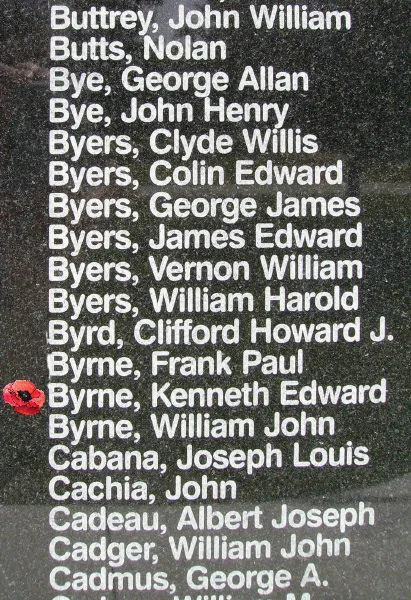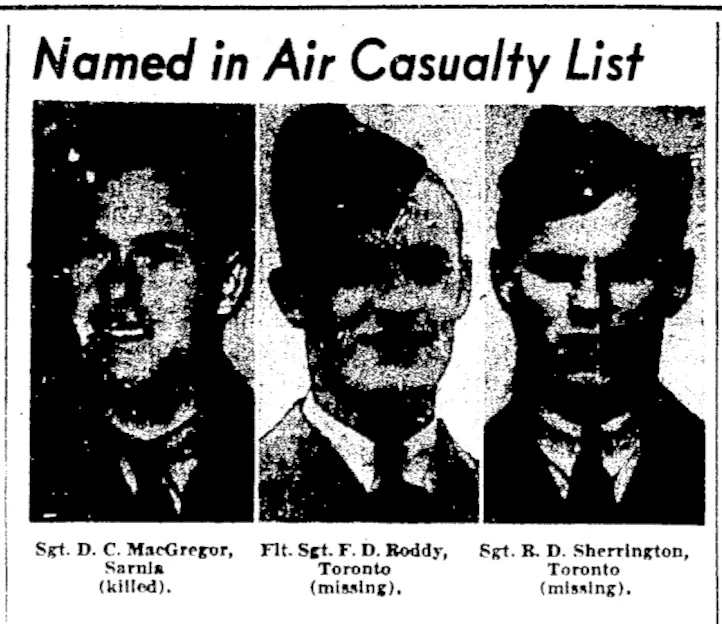Byrne, Kenneth Edward (Sergeant)
Killed in Action 1942-May-09


Birth Date: 1915
Born:
Parents: Son of Patrick J. and Mary C. Byrne, of St. John'S, Newfoundland, Canada.
Spouse:
Home: St John's, Newfoundland
Enlistment:
Enlistment Date: unkown date
Service
RAF
Unit
12 (B) Sqn- Squadron (RAF)
Leads the Field
Base
RAF Binbrook
Rank
Sergeant
Position
Wireless Air Gunner
Service Numbers
798555
Crew or Other Personnel
Wellington W5574
Wellington serial: W5574

Vickers Wellington B. Mk. III (Serial No. X3763), coded KW-E, No. 425 'Alouette' (B) Squadron, RCAF, late summer of 1942
The Vickers Wellington was a British twin-engined, long-range medium bomber. It was designed during the mid-1930s at Brooklands in Weybridge, Surrey. Led by Vickers-Armstrongs' chief designer Rex Pierson, a key feature of the aircraft is its geodetic airframe fuselage structure, which was principally designed by Barnes Wallis. Development had been started in response to Air Ministry Specification B.9/32, issued in the middle of 1932, for a bomber for the Royal Air Force. This specification called for a twin-engined day bomber capable of delivering higher performance than any previous design.
The Wellington was used as a night bomber in the early years of the Second World War, performing as one of the principal bombers used by Bomber Command. During 1943, it started to be superseded as a bomber by the larger four-engined "heavies" such as the Avro Lancaster. The Wellington continued to serve throughout the war in other duties, particularly as an anti-submarine aircraft.
It holds the distinction of having been the only British bomber that was produced for the duration of the war, and of having been produced in a greater quantity than any other British-built bomber. The Wellington remained as first-line equipment when the war ended, although it had been increasingly relegated to secondary roles. The Wellington was one of two bombers named after Arthur Wellesley, 1st Duke of Wellington, the other being the Vickers Wellesley.
In August 1936, an initial order for 180 Wellington Mk I aircraft, powered by a pair of 1,050 hp (780 kW) Bristol Pegasus radial engines, was received by Vickers; it had been placed so rapidly that the order occurred prior to the first meeting intended to decide the details of the production aircraft. In October 1937, another order for a further 100 Wellington Mk Is, produced by the Gloster Aircraft Company, was issued; it was followed by an order for 100 Wellington Mk II aircraft with Rolls-Royce Merlin X V12 engines. Yet another order was placed for 64 Wellingtons produced by Armstrong Whitworth Aircraft. With this flurry of order and production having been assured by the end of 1937, Vickers set about simplifying the manufacturing process of the aircraft and announced a target of building one Wellington per day.
A total of 180 Wellington Mk I aircraft were built; 150 for the RAF and 30 for the Royal New Zealand Air Force (RNZAF) (which were transferred to the RAF on the outbreak of war and used by 75 Squadron). In October 1938, the Mk I entered service with 9 Squadron. The Wellington was initially outnumbered by the Handley Page Hampden (also ordered by the Ministry to B.9/32) and the Armstrong Whitworth Whitley (to B.34/3 for a 'night' bomber) but outlasted both rival aircraft in service. The Wellington went on to be built in 16 separate variants, in addition to two training conversions after the war. The number of Wellingtons built totalled 11,462 of all versions, a greater quantity produced than any other British bomber. On 13 October 1945, the last Wellington to be produced rolled out. Wikipedia
Unit Desciption
12 (B) Sqn Leads the Field ()
No 12 Squadron RFC was formed at Netheravon on 4th February 1915. From 1916 to 1918 it was employed in a ground support role. It was part of the Army of Occupation at the end of WWI and was then disbanded at Bickendorf, Germany in July 1922. It was re-formed at Northolt, Middlesex in April 1923 as a bomber squadron flying DH 9A's. In 1924 it received Fairey Fawn aircraft, and later these were replaced with Fairey Foxes. From October 1935 until August 1936 it was based at Aden to reinforce RAF Middle East Command. On returning to England it re-equipped with Hawker Hinds and was based at Andover, Hampshire, until May 1939, by which time it was equipped with Fairey Battles.
From May 1939 until the outbreak of WWII the squadron was based at Bicester, Oxfordshire, the moved to France in September of 1939. It was based at a number of airfields in France, successively Berry-au-Bac, Amifontaine, Echemines and Souge. It returned to England in July 1940. During its stay in France, the squadron formed part of the Advanced Air Striking Force. During the German invasion of Belgium and France in May 1940, the squadron attacked the German invading forces, principally by trying to destroy bridges which could be used by the invading forces. On one such attack, F/O D.E. Garland (pilot) and Sgt T. Gray (observer) attacked a bridge over the Albert Canal. They were shot down and perished, but their attack appeared to have been successful and they were both awarded posthumous Victoria Crosses, the first VCs awarded to the RAF in WWII. It was clear from the heavy losses of the Fairey Battle squadrons that the aircraft was hopelessly outclassed as an effective weapon of war.
After withdrawing from France, the squadron spent a month at Finningley, Yorkshire, before moving to Binbrook, Lincolnshire in early July 1940. It was used to attack shipping in the German-held Channel ports, where shipping was being collected for the invasion of Britain, operation SEALION. During the period August-September 1940 it operated from Thorney Island, Hampshire and Eastchurch, Kent: it returned to Binbrook in September 1940. In November, the squadron began to re-equip with Vickers Wellingtons. It now flew as part of No. 1 Group of Bomber Command in its strategic bombing of Germany. It remained at Binbrook from September 1940 to September 1942, with a short diversion to Thruxton in June-July 1942. In September 1942 the squadron settled into its final home of WWI, Wickenby in Lincolnshire, where it remained until September 1945, when it returned to Binbrook.
The squadron later continued to fly bomber aircraft, namely Avro Lincoln and English Electric Canberra before being disbanded in July 1961. It was later reinstated as part of the V-bomber force, flying Avro Vulcans.
